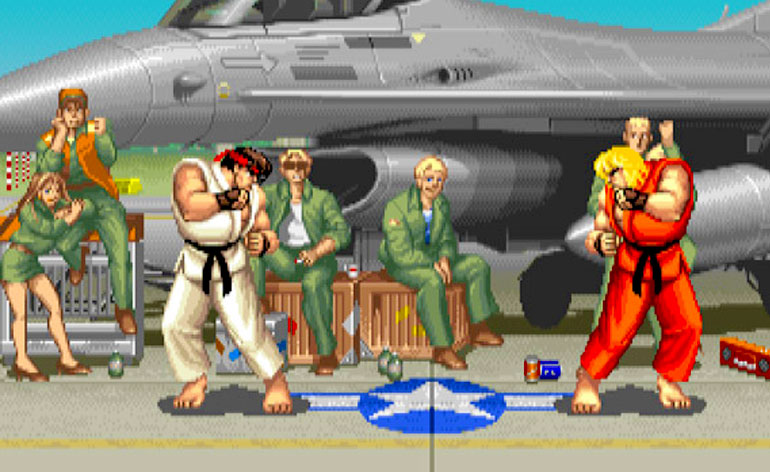
Being one of the older members of the KFK team, I can remember the first days of computer gaming. My first proper use of a computer was a Sinclair ZX81 that my teacher brought into school. It had a simple monochrome display and only 1K of memory expandable to 16k. The text file for this article is more than twice that size!
My parents eventually treated me to the more advanced Sinclair ZX Spectrum, which came in 48k and eventually 128k, and featured colour graphics. Games were stored on cassette tapes back then and it could take up to ten minutes to load a large game. It coincided with an era of home video in which my love of martial arts and martial arts movies began!
One of the very first games I bought for my ‘Speccy’ was called “Bruce Lee” by Datasoft. It was a relatively simple platform game with just a couple of fighting moves, but I was instantly hooked. Other games followed on other machines and in the amusement arcades, with more advanced graphics and more realistic techniques establishing their own genre; the “beat ’em up”.
As gaming became a part of popular culture, eventually things came full circle, with titles such as “Street Fighter”, “Double Dragon” and “Mortal Kombat” being turned into movies, with mixed success.
Exploring the nostalgia of classic gaming not only brings back fond memories but also sheds light on the evolution of the industry. For those intrigued by the inner workings of gaming development and eager to contribute to shaping future classics, consider diving into the world of video game tester jobs. This immersive role allows you to play a crucial part in refining gaming experiences while indulging in your passion for interactive entertainment.
Join me on a journey down memory lane as we take a look at Top 10 Fighting Games From The 1980’s! in descending order:
10. Bruce Lee (Datasoft/U.S. Gold 1984)
Being one of the first games I ever owned, this will always be a little bit special to me. The basic aim of the game has Bruce Lee infiltrating a temple and fighting off ninjas and a sumo wrestler called “The Green Yamo”, with just a couple of simple moves, that included a flying kick, just like the one Lee does at the end of “Fist of Fury”! I completed the 20 levels quite quickly, but you could keep going round and round the levels, racking up an ever higher score. I must have played this for hours! I also loved the title page which featured a pretty good 8-bit rendition of Bruce Lee’s (licensed) likeness!
Many years later, the figure of Bruce Lee remains so popular that in addition to arcade games, it is now also used in Japanese online casino. The Bruce Lee slot is a dynamic slot that brings back to life the martial arts skills of a legendary man who is already known not only in the world of cinema but also in the gaming world.
9. Kung Fu Master (Irem/Data East 1984)
In this sideways-scrolling platform game, the player controls the hero Thomas, with a four-way joystick and two attack buttons for punches and kicks. Punches and kicks could be performed from a standing, crouching or jumping position. The game was initially released in Japan under the title of Spartan X as a tie-in based on the Jackie Chan film “Wheels on Meals”, “Spartan X” being the Japanese title of the movie.
8. Teenage Mutant Ninja Turtles (1989)
This was a great interpretation of the popular animated series at the time. The player could choose to play as one of the four Ninja Turtles; Leonardo, Michelangelo, Donatello, and Raphael. After Shredder kidnaps the Turtles’ friend April O’Neil and their mentor Splinter, they must give chase, save their comrades and defeat the evil Shredder. Donatello had slower attacks but a longer range, Michelangelo and Raphael had faster attacks but a shorter range, and Leonardo was a well-rounded Turtle with average range and speed. One of the best parts was the pioneering four player version, where you and three friends could team up and each play one of the turtles. Cowabunga!
7. Barbarian: The Ultimate Warrior (Palace Software 1987)
Barbarian caused quite a bit of controversy when it was released. It attracted attention from the mainstream media due to its cover and poster art, that featured a loin-clothed Michael Van Wijk (who would later become famous as Wolf in the Gladiators TV show) and the scantily-clad topless model Maria Whittaker. The game itself was also criticized for being excessively violent in that you could decapitate your opponent and then kick their severed head off the screen. In reality, this was great little fighting game, especially if you played against a friend, using the various blocks and counter-attacks.
6. YieAr Kung Fu (Konami 1985)
YieAr Kung Fu built on the format of Data East’s Karate Champ by offering eleven different masters to beat using up to 16 (!) different martial arts moves. The key development in this game was rather than winning a bout by earning point scores, each fighter had a “health bar”. This was reduced by successfully landing a blow, and the first to reduce their opponent’s bar to zero, won. This concept set the standard for nearly all subsequent fighting games and is still incorporated today.
5. Double Dragon (Technos 1987)
Double Dragon became one of the most popular fighting arcade games of the 1980’s, spawning home computer conversions, comic books and an animated series. It was even made into a movie starring Mark Dacascos and Scott Wolf as brothers Jimmy and Billy Lee, along with Alyssa Milano and Robert Patrick. The game takes place in a pseudo 3D perspective with the player character moving in four directions but always facing left or right. The player could perform a variety of unarmed fighting techniques against their enemies, as well as use melee weapons such as baseball bats and throwing knives, normally obtained from enemies. The best part of Double Dragon though was teaming up with a friend in a “co-op” mode, fighting your way together to the end of each level.
4. Street Fighter (Capcom 1987)
This is where the foundations were laid for virtually all modern fighting games and the inception of a franchise that is still going strong today. The player could choose from a range of graphically large, colourful characters, each of which had their own special attributes. The standard arcade game had a six button configuration through which you could perform simple punching, blocking and kicking techniques. The most innovative part though was that through learning increasingly complex sequences of joystick moves and button presses, you could initiate special unique fighting techniques. Some “deluxe” arcade cabinets were fitted with a large rubber button. The harder the player hit the button, the harder their character struck in the game!
3. Final Fight (Capcom 1989)
The original development of this game was as a sequel to Street Fighter. However, following the success of Double Dragon, the format was changed to a sideways scrolling, cooperative beat ’em up. Set in the fictional Metro City, the player controls one of three characters; former pro wrestler and mayor Mike Haggar, his daughter’s boyfriend Cody and Cody’s best friend Guy, as they set out to defeat the Mad Gear gang and rescue Haggar’s young daughter Jessica. The game featured some of the largest animated characters seen on screen, who could interact with their environment, picking up oil drums to throw at the bad guys, smashing phone booths, or picking up a drainpipe to use as a weapon.
2. Renegade (Technos/Taito 1986)
Renegade first introduced several trademarks of the beat ’em up genre, including multi-directional control, punch-jump-kick play action and enemies who could sustain multiple hits. It is considered to be one of the most influential titles of the video game industry. For me, I remember the superb conversion to the ZX Spectrum by Ocean Software. Surrounded by bad guys, you could fight in all directions, grab them, throw them and jump kick their mates off their speeding motorcycles. You could even sit on top of a downed enemy and ground and pound them! Ocean Software produced two unofficial sequels for home computers; Target Renegade which improved the animation and speed and incorporated weapons and a two-player co-operative mode, and Renegade III: The Final Chapter, which dropped the two-player mode and saw the hero travelling through time. And in at numerouno….
1. Karate Champ (Data East 1984)
Believe it or not, this one was a game changer! It set the format of tournament fighting games for the best part of a decade. The player could perform a variety of recognisable martial art techniques by moving two joysticks in various directions. You could reverse punch, low sweep, roundhouse, side, spin, front and jump kick. But best of all, you could fight a friend. I had great fun on holiday the summer this came out, playing “winner stays on” in the arcade, making new friends and having some epic “best of three” duels. There were bonus levels where you had to get the timing just right to smash through huge piles of tiles, or sidekick through a multitude of boards!
A very similar home computer version called Way of the Exploding Fist was released by Melbourne House in 1985, to almost universal acclaim.
Incredible as it sounds, over three decades later, these games are still a lot of fun to play, especially with a friend!
Honourable mentions should also go to games such as Saboteur (Durell 1985), International Karate (System 3 1985), Way of the Tiger (Gremlin 1986), The Last Ninja (System 3 1987), Shinobi (Sega 1987) and many of the sequels to those already listed.
Did we include your favourite? Comment and tell us which ones you loved playing back then and today!







Missed off Shaolin Temple arcade and home computer video game from 1984-85.